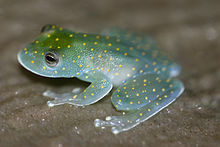Cochranella euknemos, sometimes known as the San Jose Cochran frog, is a species of frog in the family Centrolenidae. It is found in central Costa Rica and south/eastward to Panama and to the western flank of the Cordillera Occidental in Colombia (Antioquia and Chocó Departments).[2][3][4][5] Some Colombian records might apply to Cochranella mache.[2]
| Cochranella euknemos | |
|---|---|

| |
| Scientific classification | |
| Domain: | Eukaryota |
| Kingdom: | Animalia |
| Phylum: | Chordata |
| Class: | Amphibia |
| Order: | Anura |
| Family: | Centrolenidae |
| Genus: | Cochranella |
| Species: | C. euknemos
|
| Binomial name | |
| Cochranella euknemos (Savage and Starrett, 1967)
| |
| Synonyms[2] | |
|
Centrolenella euknemos Savage and Starrett, 1967 | |
Description
editCochranella euknemos are small frogs, males growing to 25 mm (0.98 in) and females to 32 mm (1.3 in) in snout–vent length. They are dorsally blue-green and a little granular, with many small whitish or yellowish spots. Ventrally they are transparent white, but with more yellow on the undersides of the arms and legs. Iris is grayish ivory. Feet are moderately webbed.[4]
Reproduction
editIn Costa Rica, males call in May–November. Egg masses are gelatinous and laid on the tips of leaves overhanging streams.[4]
Habitat and conservation
editThe species' natural habitats are humid lowland, premontane, and montane forests. It occurs in bushes and trees along forest-covered streams.[1] Its altitudinal range is 100–1,940 m (330–6,360 ft) asl in Colombia,[3] somewhat narrower elsewhere.[2]
Cochranella euknemos is generally threatened by deforestation in Panama,[1] and east of the Panama Canal, chytridiomycosis.[4] In Costa Rica it has declined and has not been seen since 1986, despite dedicated survey efforts, but the reasons for this decline are not currently known.[1]
References
edit- ^ a b c d IUCN SSC Amphibian Specialist Group (2020). "Cochranella euknemos". IUCN Red List of Threatened Species. 2020: e.T54960A3021342. doi:10.2305/IUCN.UK.2020-3.RLTS.T54960A3021342.en. Retrieved 17 November 2021.
- ^ a b c d Frost, Darrel R. (2019). "Cochranella euknemos (Savage and Starrett, 1967)". Amphibian Species of the World: an Online Reference. Version 6.0. American Museum of Natural History. Retrieved 6 July 2019.
- ^ a b Acosta Galvis, A. R. (2019). "Cochranella euknemos (Savage & Starrett, 1967)". Lista de los Anfibios de Colombia: Referencia en linea V.09.2019. Retrieved 6 July 2019.
- ^ a b c d "Cochranella euknemos Savage and Starrett 1967". Amphibians of Panama. Smithsonian Tropical Research Institute. Archived from the original on 19 June 2015. Retrieved 19 June 2015.
- ^ Luis Humberto Elizondo C. & Federico Bolaños V. (2012). "Cochranella euknemos". Biodiversidad de Costa Rica. Instituto Nacional de Biodiversidad. Archived from the original on 19 June 2015. Retrieved 19 June 2015.
